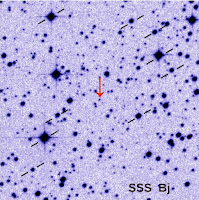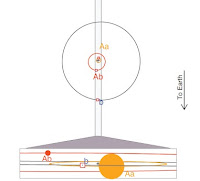Almost all planets orbiting other stars have been discovered by one of two planetary detection techniques: occlusion, on which the planet passes in front of the star, causing the amount of light reaching us from that star to dim ever so slightly on a regular timescale, or radial velocity, in which the gravity of the planet causes the host star to wobble back and forth by a small, but detectable, amount, again on a regular timescale. However both of these techniques can be hampered if stars thought to be singular are in fact part of a binary system, in which a smaller stellar companion causes the main star to wobble instead of or in addition too the wobble caused by any planet, and the occlusion of one star by another causes brightening and dimming just as well as any planet. Since it is thought that about half the stars in our galaxy are part of binary systems, this is a serious consideration for planet-hunters.
In a paper published on the online arXiv database at Cornell University Library on 2 September 2016, Justin Wittrock and Stephen Kane of the Department of Physics & Astronomy at San Francisco State University, Elliot Horch of the Department of Physics at Southern Connecticut State University, Lea Hirsch of the Astronomy Department at the University of California at Berkeley, Steve Howell of the NASA Ames Research Center, David Ciardi of the NASA Exoplanet Science Institute, Mark Everett of the National Optical Astronomy Observatory, and Johanna Teske of the Carnegie Department of Terrestrial Magnetism, describe the discovery of two faint companions to planet hosting stars made with the Differential Speckle Survey Instrument at the Gemini-North Observatory.
The first system examined is the HD 2638 system, which currently comprises a G5V star (Yellow Dwarf star slightly smaller than our Sun), 49.93 parsecs (162.8 light years) from us in the constellation of Cetus. This star is calculated to be about 5.1 billion years old, and to have about 87% of the Sun's mass and an effective surface temperature of 5173 K (compared to 5778 K for our Sun). This star is thought to be orbited every 3.43 days by a planet with a mass 48% of that of Jupiter, orbiting at a distance of 0.044 AU (i.e. 0.044 times the distance between the Earth and the Sum or about 10% of the distance at which Mercury orbits the Sun.
A companion star to this system was announced by another team in 2015 (between the time when the Gemini-North observations were made and the publication of the results), a discovery which Wittrock et al. confirm. By their calculations this star is an M1V (Red Dwarf) star with a mass 48% of that of the Sun and an effective surface temperature of 3571 K, orbiting the main star at a distance of 25.5 AU (for comparison Uranus orbits the Sun at a distance of 19.2 AU).
Gemini DSSI speckle image of HD 2638 at 880 nm. The field-of-view is 2.8 × 2.8”. North is up and East is to the left. The source in the center is HD 2638, and a bright source to the bottom and slightly to the left of the main star is the stellar companion. Wittrock et al. (2016).
Potentially the presence of a second star in a stellar system can influence both the possibility of planet forming and our ability to detect them. Wittrock et al. calculate that the presence of a second, smaller star orbiting the main star in the HD 2638 system at a distance of 25.5 AU would prevent any planets from forming and remaining in stable orbits outside 8 AU from the main star - not an issue for the known planet of HD 2638, which orbits at a distance of 0.044 AU. The planet was detected by the radial velocity technique; it was possible to detect the wobbling of the main star caused by a planet orbiting it every 3.4 days. Potentially this signal could be influenced by the gravity of a second star, but Wittrock et al. calculate that the second star would have an orbital period of 110 years, so confusion of the signal caused by that of the planet and that of the star seems highly unlikely.
The second system discussed is HD 164509, another G5V (Yellow Dwarf) star, 52.44 parsecs (171 light years) from Earth in the constellation of Ophiuchus. The primary star in this system is calculated to be 3.2 billion years old and to have 1.10 times the mass of the Sun and an effective surface temperature of 5860 K. This is orbited every 282 days by a planet with a mass 48% of that of Jupiter at a distance of 0.875 AU (for comparison Venus orbits the Sun at 0.723 AU ans Earth at 1 AU).
Wittrock et al. announce the discovery of a previously unknown companion to this star, a Red Dwarf star with a mass 42% of the Sun's and an effetive surface temperature of 3446 K, orbiting at a distance of 36.5 AU (for comparison Neptune orbits the Sun at a distance of about 30 AU, and Pluto at an average distance of 39.5 AU.
Gemini DSSI speckle image of HD 164509 at 880 nm. The field-of-view is 2.8×2.8”. North is up and East is to the left. The source in the center is HD 164509, and a bright source to the bottom and right of the main star is the stellar companion. Wittrock et al. (2016).
Again Wittrock et al. note that such a planet could affect the formation, orbital stability and detectability of any planets in the system; the presence of the second star would prevent planets from forming in a stable orbit more than 13 AU from the primary star - again not an issue for the close-in planet of HD 154509. This planet was also detected by the radial velocity method, though in this case it would take the secondary star 180 years to complete a single orbit about the primary star, so it is unlikely that this star could be responsible for the signal interpreted as coming from the planet.
See also...
 When Schotz’s Star passed through the Solar System’s Oort Cloud. It is estimated that about 30% of impact craters larger than 10 km
on the Earth and the Moon have been caused by long period comets originating in
the Oort Cloud (the very outermost part of the Solar System, between about 30
AU and about 120 000 AU from the Sun, which is to say between 30 and 120 000
times as far from the Sun as the Earth. In the 1980s it...
When Schotz’s Star passed through the Solar System’s Oort Cloud. It is estimated that about 30% of impact craters larger than 10 km
on the Earth and the Moon have been caused by long period comets originating in
the Oort Cloud (the very outermost part of the Solar System, between about 30
AU and about 120 000 AU from the Sun, which is to say between 30 and 120 000
times as far from the Sun as the Earth. In the 1980s it... The planets of NN Serpentis. The NN Serpentis system comprises a young binary pair of stars 1670
light years from Earth in the constellation of Serpens. The pair
comprises a White Dwarf star with 53.5% of the Sun's mass and a Red
Dwarf star with 11% of the Sun's mass orbiting at a distance of 1.5 AU
(1.5 times the distance at which the Earth orbit's the Sun, or slightly
under the radius of...
The planets of NN Serpentis. The NN Serpentis system comprises a young binary pair of stars 1670
light years from Earth in the constellation of Serpens. The pair
comprises a White Dwarf star with 53.5% of the Sun's mass and a Red
Dwarf star with 11% of the Sun's mass orbiting at a distance of 1.5 AU
(1.5 times the distance at which the Earth orbit's the Sun, or slightly
under the radius of... Citizen scientists discover a sub-Jovian planet in a quaternary star system. The Planet Hunters is a
citizen science project (i.e. a science project carried out largely by
members of the public) which asks visitors to a website to look at
randomly selected 30 light-curves from the Kepler Space Telescope,
and look for patterns. Volunteers who find patterns that may indicate
planets can...
Citizen scientists discover a sub-Jovian planet in a quaternary star system. The Planet Hunters is a
citizen science project (i.e. a science project carried out largely by
members of the public) which asks visitors to a website to look at
randomly selected 30 light-curves from the Kepler Space Telescope,
and look for patterns. Volunteers who find patterns that may indicate
planets can...
Follow Sciency Thoughts on Facebook.


